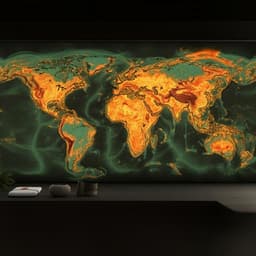
Earth Sciences
Sustained increase in suspended sediments near global river deltas over the past two decades
X. Hou, D. Xie, et al.
Join Xuejiao Hou, Danghan Xie, Lian Feng, Fang Shen, and Jaap H. Nienhuis as they explore global patterns of coastal suspended sediment concentration and river sediment plume area near deltas. This groundbreaking study reveals significant increases in sediment levels, posing intriguing questions about their implications for wetland resilience against climate change, all while navigating the complex influences of natural coastal processes.
~3 min • Beginner • English
Introduction
Suspended sediments in coastal oceans are critical for sustaining coastal wetlands, ecosystems, and deltas. Global-scale assessments indicate declines in fluvial sediment supply due to widespread dam construction, which is often assumed to reduce coastal SSC and heighten wetland loss risk. However, evidence linking reduced river sediment supply to declines in coastal SSC is mixed, with some records showing increased coastal sediment deposition in the 20th century. Coastal SSCs are influenced by interactions between river flow, tides, waves, and sediment transport processes. Prior global SSC assessments using satellites suggested decreases but covered limited periods (e.g., 2003–2012), and drivers remained unclear. Well-studied individual deltas (e.g., Yangtze, Mekong) show SSC declines linked to damming, but whether these patterns are global is unknown. This study uses 2000–2020 satellite observations to address: (i) spatial and temporal patterns of coastal SSC near global deltas, (ii) SSC response to changes in river sediment supply, and (iii) other controls on coastal SSC.
Literature Review
Previous work documents global declines in river sediment loads due to damming and human impacts, often assumed to translate to reduced coastal SSC and increased wetland vulnerability. Yet compiled records show coastal sedimentation increased in the 20th century despite dams, implying additional controls from hydrodynamics and sediment processes. Earlier satellite-based global SSC assessments (e.g., 2003–2012) reported widespread decreases but suffered from short records and unclear drivers. Case studies for Asian megadeltas (Yangtze, Mekong) documented SSC declines following dam construction and sediment extraction. Studies also show SSC is modulated by tides, waves, salinity (including flocculation and settling), and estuarine circulation, with wind and wave conditions affecting plume extent and SSC distribution. These findings motivate a longer-term, globally consistent assessment and explicit attribution to multiple drivers.
Methodology
Study domain: 349 river deltas worldwide spanning six continents and a range of morphologies (river-dominated n=136, tide-dominated n=87, wave-dominated n=126), collectively representing 64.2% of global river water discharge.
Remote sensing of SSC: Used MODIS Terra and Aqua 8-day surface reflectance (SR) products at 500 m resolution (0.31 million Terra composites, 2000–2020; 0.27 million Aqua composites, 2002–2020; total 0.58 million composites). A recalibrated global coastal SSC algorithm (Yu_adapted) was selected based on in situ calibration/validation from multiple datasets (Pearl River, Yangtze, YECS, SeaSWIR, CoastColour Round Robin, AquaSat). The chosen algorithm achieved RMSE 24.9% overall (clear waters 24.9%, turbid waters 49.1%). MODIS-derived SSCs were cross-validated against Sentinel-3 OLCI (4 km) monthly SSC (2016–2020) and literature values, showing consistent magnitude and trends.
Algorithm: SSC = exp(0.859*(0.145*(R555/R469) + (5.167*(R645/R555)*(R645/(R645+R859)) + (7.244*(R859/R555)*(R859/(R645+R859)))))^0.990), using MODIS SR bands (469, 555, 645, 859 nm).
RPA delineation: For each delta, determined an SSC threshold (5th percentile of median SSC within a 5-km buffer at the river mouth across 251 months). The study region boundary comprised pixels exceeding this threshold in at least 70% of months (sensitivity showed <5% SSC change for 50–70%). Monthly RPA is the maximum extent of pixels with SSC above the threshold within the study region. Images/months retained if >50% valid coverage; gaps were filled using adjacent months or same month in adjacent years; high-latitude seasonal gaps acknowledged.
Drivers and ancillary data: Annual/multi-year monthly river sediment flux (Qriver) from a global dataset (Landsat-derived SSC combined with station discharge) for 186 deltas; monthly tidal sediment flux proxy (Qtide) derived from tidal amplitude (TPXO), angular velocity, slope, efficiency, upstream depth, and aspect ratio; daily wave sediment flux (Qwave) from NOAA WaveWatch III (2000–2009), aggregated to monthly and annual means; for 2010–2020 Qwave mean of 2009 was used; monthly salinity (GLORYS12V1, 1/12°) available for 139 deltas; delta morphology from prior global classification; tidal wetland change (1999–2019) for 180 deltas.
Trend analysis: Computed monthly anomalies (difference from monthly climatology) for SSC and RPA, then applied Mann-Kendall test with Sen’s slope to estimate long-term trends (per year), assessing significance at p<0.05. Similar trend analyses for annual Qriver, Qtide, Qwave, and salinity.
Attribution: Correlation analyses between log-transformed SSC and each driver (Qriver, Qtide, Qwave, salinity). Multiple general linear model (GLM) on 139 deltas (all drivers available) to estimate relative contributions using MeanSq ratios; significance at p<0.05.
Data/code: MODIS-derived SSC dataset deposited at Figshare (accession provided); code available via Code Ocean.
Key Findings
- Global SSC and RPA increases (2000–2020): SSC +0.46% yr−1 (+0.23 mg/L yr−1, p<0.05); RPA +0.48% yr−1 (+0.64 km² yr−1, p<0.05). 59% (206/349) of deltas show SSC increases; deltas with significantly increasing RPA outnumber those decreasing by 78.2%.
- Spatial patterns: SSC increases across most continents; strongest increases in Africa (+0.41 mg/L yr−1) and North America (+0.32 mg/L yr−1). Asia shows mean SSC decline (−0.10 mg/L yr−1), despite increases at high northern latitudes (>45°N). Arctic deltas exhibit pronounced SSC increases (+1.29 mg/L yr−1), 18.4× non-Arctic rates.
- RPA regional trends: Largest RPA increases in North America (+1.94 km² yr−1) and Oceania (+0.72 km² yr−1); notable decreases for major Asian rivers (e.g., Yangtze −64.2 km² yr−1; Mekong −2.8 km² yr−1). Arctic RPA increases average +3.94 km² yr−1 vs +0.23 km² yr−1 for non-Arctic.
- Morphology: River-dominated deltas show the strongest SSC increases (62% increasing; mean +0.36 mg/L yr−1). Over 62% of river- and tide-dominated deltas show increasing RPA; wave-dominated deltas are more prone to SSC decreases long-term.
- Long-term mean characteristics (2000–2020): SSC ranges 2.8–379.7 mg/L (median 29.1 mg/L). 21.5% of deltas have mean SSC <10 mg/L; 31.5% >50 mg/L. Higher SSCs cluster in Asia (median 41.0 mg/L) and some Arctic rivers; Europe shows lower SSCs (median 20.9 mg/L). Tide-dominated deltas have higher median SSC (35.1 mg/L) than wave-dominated (16.3 mg/L). RPA median globally 54.8 km²; North America median 78.8 km² with cases of large RPA but low SSC (e.g., Saguenay mean SSC 8.7 mg/L, RPA 151.5 km²; Mississippi 43.1 mg/L, RPA 750.9 km²). Arctic RPAs exceed non-Arctic by >2×.
- SSC-driver relationships (log-scale correlations): SSC vs Qriver r=0.23 (p<0.05, n=186); SSC vs Qtide r=0.31 (p<0.05, n=186); SSC vs Qwave r=−0.40 (p<0.05, n=186); SSC vs salinity r=−0.38 (p<0.05, n=139). Seasonal SSC is also significantly negatively correlated with salinity (R=−0.61, p<0.05).
- Attribution (GLM, 139 deltas): Changes in Qriver, Qtide, Qwave, and salinity significantly (p<0.05) account for SSC changes in 36%, 13%, 9%, and 7% of deltas, respectively; combined, these drivers explain 84.3±14.2% of SSC variability. Increases in Qriver and Qtide along Atlantic coasts of the Americas drive SSC increases there; decreases in Qriver/Qtide and increases in Qwave and salinity align with SSC declines in South Asia.
- River supply vs coastal SSC: Up to 45.2% of deltas show opposing long-term trends between river sediment supply and coastal SSC, indicating substantial modulation by tides, waves, salinity, morphology, and estuarine dynamics.
- SSC–RPA covariation: No consistent global covariation between SSC magnitude and RPA extent, likely due to three-dimensional estuarine processes and wind/wave effects controlling surface expression and plume spreading.
- Wetlands: Despite overall SSC increases, nearly one-third of wetlands (of 180 matched deltas) experienced net area loss, implicating human activities, subsidence, and sea-level rise as additional controls.
Discussion
The study demonstrates widespread increases in coastal SSC and plume extent near global deltas over two decades, challenging the assumption that reduced fluvial sediment supply necessarily leads to diminished coastal SSC and increased wetland vulnerability. While river sediment flux increases can elevate SSC, the response is delta-specific; a substantial fraction of deltas show opposing trends between river sediment supply and SSC due to modulating factors. Tides and waves act on multiple timescales: waves may transiently raise SSC yet reduce long-term SSC in wave-dominated systems lacking distributary networks, whereas river- and tide-dominated deltas more efficiently retain sediments, supporting persistent SSC gains. Salinity exerts a negative control on SSC through freshwater dilution, flocculation, and settling dynamics.
The lack of consistent SSC–RPA covariation highlights measurement and process complexities: satellite observations capture surface SSC and plume extent but may miss near-bed and three-dimensional estuarine processes (tidal pumping, density-driven circulation) and wind-driven dispersal, which can decouple surface SSC from plume area. Hyperpycnal flows further complicate the SSC–Qriver linkage by routing sediments beneath the surface, reducing surface SSC signals during high-density events.
Implications include potentially greater resilience of coastal wetlands to sea-level rise than previously estimated, given increasing SSC; however, wetland trajectories are also governed by human alterations, subsidence, and sea-level rise. Management should consider that restoring river sediment supply alone may not uniformly translate to higher coastal SSC; local hydrodynamics and salinity regimes are critical. Elevated SSC can foster mudflat formation and habitat expansion but also increase turbidity, reduce light availability, and transport pollutants, necessitating site-specific assessments.
Conclusion
Using two decades of global satellite observations, the study provides a comprehensive assessment of coastal SSC and plume dynamics near 349 river deltas, revealing global increases in SSC and RPA except in parts of Asia. These increases are partly attributable to river sediment supply but are strongly modulated by tides, waves, salinity, and morphology, explaining SSC gains in many deltas despite reduced fluvial sediment flux. The findings inform evaluations of deltaic sediment balance and wetland resilience to sea-level rise and offer a dataset for coastal management and restoration planning. Future work should improve three-dimensional characterization of sediment dynamics (including subsurface SSC and hyperpycnal contributions), extend wave datasets beyond 2009, refine Qriver estimates in meso/micro-tidal systems via coupled remote sensing–modeling, and better integrate SSC changes with wetland dynamics and human impacts.
Limitations
- Observations reflect surface SSC and surface plume extent (RPA); subsurface and near-bed sediment dynamics are not captured, potentially underrepresenting hyperpycnal contributions.
- Use of MODIS SR (land atmospheric correction) may introduce errors in clear waters compared to ocean color Rrs products; spatial resolution differences with OLCI (4 km) contribute to bias at high SSC (>100 mg/L).
- Qwave available only through 2009; mean 2009 value used for 2010–2020 introduces uncertainty in trend and attribution analyses post-2010.
- Qriver derived from remote sensing and station discharge may be less accurate in meso/micro-tidal estuaries where 3D effects are strong; river channel SSC magnitudes differ from coastal SSC.
- Salinity data available for only 139 of 349 deltas; coarse resolution (1/12°) may not resolve nearshore gradients.
- Monthly data gaps (e.g., high-latitude winters) and requirement for >50% valid coverage may affect some trend estimates; limited sensitivity analyses address these choices.
- Lack of consistent SSC–RPA covariation suggests process and observational limitations (e.g., wind effects, estuarine circulation) that complicate simple interpretations.
Related Publications
Explore these studies to deepen your understanding of the subject.







